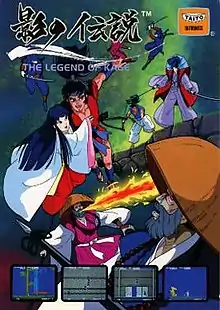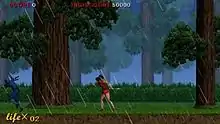The Legend of Kage
The Legend of Kage (影の伝説, Kage no Densetsu) is a 1985 arcade game by Taito which was released for several contemporary video game home systems in the following years.
| The Legend of Kage | |
|---|---|
 Arcade flyer | |
| Developer(s) | Taito Imagine Studios (CPC/C64) |
| Publisher(s) |
|
| Composer(s) | Hisayoshi Ogura |
| Series | The Legend of Kage |
| Platform(s) | Arcade, Amstrad CPC, Commodore 64, Famicom/NES, MSX, X1, ZX Spectrum |
| Release | |
| Genre(s) | Action |
| Mode(s) | Single player |
Plot
The player takes the role of a young Iga ninja named Kage ("Shadow"), on a mission to rescue Princess Kiri (hime) - the Shogun's daughter - from the villainous warlord Yoshi (ro Kuyigusa) and fellow evil samurai Yuki (nosuke Riko). Kage must fight his way through a forest, along a secret passageway, up a fortress wall, and through a castle, rescuing her twice (three times in the FC/NES version) in order to win the game. Each time the princess is rescued, the seasons change from summer to fall to winter and back to summer.
Cast of characters
- Kage (Iga Ninja)
- Kirihime (Princess)
- Shinobi (Red or Blue Fuuma Ninja)
- Yobo (Red or Blue Magic Monk)
- Yukinosuke Riko (Samurai)
- Yoshiro Kuyigusa (Warlord)
Gameplay
.png.webp)
The player is armed with a kodachi shortsword and an unlimited number of shuriken. Main gameplay revolves around killing enemy ninja (blue and red) and enemy fire-breathing monks over five stages:
- The first stage is a horizontal and vertically scrolling forest, with the player able to jump quite high (more than a screen height), and able to grab/scale trees that are several screen heights. Grabbing a book causes Kage to stand still and meditate for several seconds while approaching enemies drop to the ground dead during a lightning storm.
- The second stage is horizontally scrolling at the water's edge. The lower half of the screen is underwater, where ninja (blue and red) appear with breathing tubes. The player must kill ten ninja to advance. The player can jump into the water section, but mobility is severely hampered.
- The third stage is another bi-scrolling stage. The player must jump continuously to reach the temple at the top.
- The fourth stage is the temple. The player goes up the four sets of stairs, avoiding or killing enemy ninja and monks, to rescue Princess Kiri.
- The fifth stage is a boss stage. It starts at the top of the temple, and then Kage and Kiri jump off the temple back to the forest, where Kiri is re-kidnapped by the boss. The player must kill the boss.
In home versions, grabbing a crystal ball causes the player's clothes to change to the next level in color and thereby attain certain powers (bigger shuriken or faster speed). If Kage is hit in a home version while in green or orange clothes, he does not die but reverts to his normal red clothes.
Cycles repeat after five levels are completed, and play continues until all lives are gone, which ends the game.
Reception
In Japan, Game Machine listed The Legend of Kage on their November 15, 1985 issue as being the most-successful table arcade unit of the year.[1]
Legacy
Re-releases

The Famicom/NES version was re-released on the Wii Virtual Console in Japan on December 19, 2006, and in the United States on February 19, 2007.[2][3] It was also released for the 3DS Virtual Console and Wii U Virtual Console in Japan.[4][5] The arcade version also appears in the compilation title Taito Legends 2.
A 3D graphics remake of the arcade game along with the original arcade version is included in the 2006 compilation Taito Legends Power Up for the PlayStation Portable. The game is still side-scrolling.
The Revised Legend of Kage was included in the Taito Nostalgia 1 release along with the original game. It features two new playable characters, Ayame and Ganin. Ayame is a ninja who can throw bombs similar to the red ninja in the game and has an unlimited supply of throwing knives. Ganin is a dog who can breathe fire similar to the monks in the game and can perform a spin attack that does not have much range but leaves him invulnerable for an instant and kills any enemy that touches him. There is also a new final boss that all the characters face which is a giant green cobra that slithers on the ground back and forth on the screen at the end of each second run through the levels. It is the only enemy that does not jump into the air.
Sequel
A follow-up game was developed by Lancarse for the Nintendo DS, and published by Taito in 2008. Taito's parent company, Square Enix, published a North American localization of the game later that year.
See also
- Taito's 1984 laserdisc video game Ninja Hayate features a similar scenario of a young ninja (who even looks like Kage) attempting to rescue a kidnapped princess.
- Taito's 1989 game Demon Sword is similar in gameplay to The Legend of Kage.
References
- "Game Machine's Best Hit Games 25 - テーブル型TVゲーム機 (Table Videos)". Game Machine (in Japanese). No. 272. Amusement Press, Inc. 15 November 1985. p. 21.
- https://www.nintendo.co.jp/wii/vc/vc_kd/
- https://www.nintendo.com/games/detail/KeAEUuryiYE6ptB6DKjkThz6hi0lDCiP
- https://www.nintendo.co.jp/titles/50010000019595
- https://www.nintendo.co.jp/titles/20010000005405
External links
- Legend of Kage at the Killer List of Videogames
- Legend of Kage at Lemon 64
- The Legend of Kage NES instruction manual
- The Legend of Kage at SpectrumComputing.co.uk